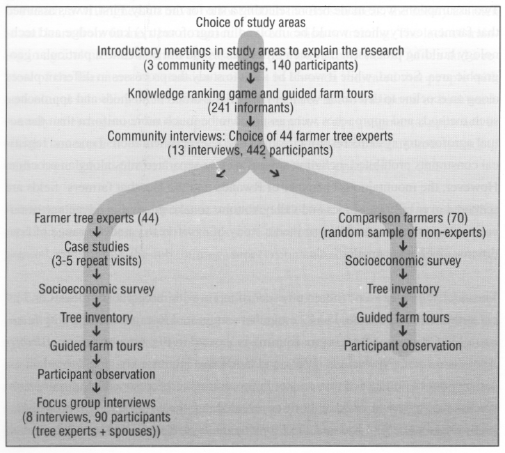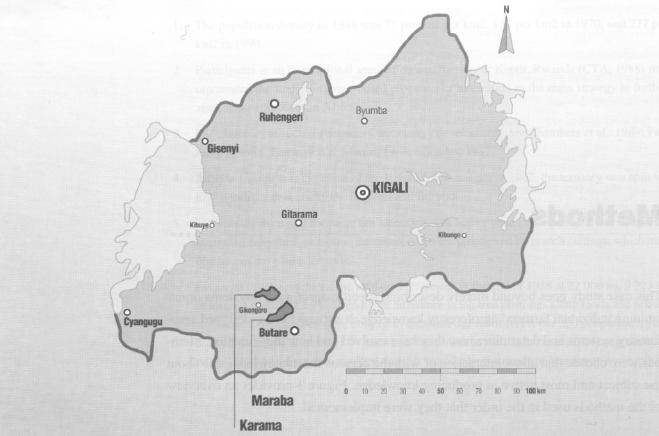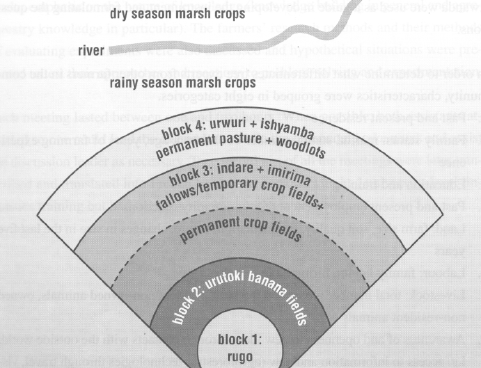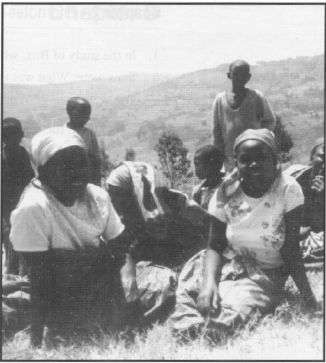


This case study goes beyond merely describing specific agroforestry systems or examining individual farmers' agroforestry knowledge. It surveys farmer-designed agroforestry systems and determines how they have evolved and how they function. Methods were chosen that allow interaction of with the persons most knowledgeable about the subject and most active in producing knowledge. Figure 1 provides an overview of the methods used in the order that they were implemented.


Two assumptions were made before selecting a site for the study. First, it was assumed that farmers everywhere would be involved in (agroforestry) knowledge and technology building processes; that such processes would not be tied to a particular geographic area. Second, while it would be ideal to study the processes in different places along an ecocline to determine whether farmers use different methods and approaches, such methods and approaches were assumed to be much more uniform than the actual agroforestry systems resulting from farmers' experimentation. Time and logistical constraints prohibited including several widely-separated sites along an ecocline. However, the mountainous character of Rwanda and the fact that farmers' fields are scattered over hilltops, slopes and valley bottoms to take maximum advantage of micro-ecological features still permitted a study of agroforestry under a range of conditions, albeit on a smaller scale.
The case study area were chosen after consultation with researchers of ISAR and local authorities in Rwanda. ISAR researchers suggested Karama municipality (commune) in Gikongoro Prefecture. Karama is located in the zone of action of Projet Agro-Pastoral de Nyabisindu (PAP), and ISAR was interested in an independent assessment of the impact of this project in promoting agroforestry. The initial visit to discuss the study with local authorities revealed that there was a second project promoting agroforestry in Karama, the Projet Agricole de Karama led by a Belgian volunteer. Since the objective of this case study was to understand how farmers build agroforestry knowledge on their own, there was a concern that the presence of these projects would unduly influence these processes. However, because ISAR was the host institution, it was politically impossible to reject Karama as a study site. Thus it was determined to look for a second site that had never been part of a development project. Within Gikongoro Prefecture and neighbouring Butare Prefecture, three such locations existed-the muncipalities of Maraba, Ruhashya and Rusatira. Maraba was chosen as the second study site. Ruhashya was rejected because the main ISAR research station, Rubona, is located there, which means that farmers are frequent targets of surveys by Rubona researchers and are suffering from `survey fatigue'. Rusatira was rejected because its location made it too awkward to coordinate activities at the two sites. The location of the two chosen sites is given in Map 3.
The specific study sites within Maraba and Karama were selected after discussions with the local authorities and extension personnel. In Maraba, the two districts (secteurs) of Simbi and Maraba were chosen. They are located in the centre and the southwest part of the municipality respectively. In Karama, Kibingo district was chosen. It is a long and narrow, L-shaped district that dissects Karama from north to south. More detailed descriptions of the research sites will be given in Chapter III.
Two local research assistants were chosen to help during the actual data collection (May-Dec, 1992), one from Maraba and one from Karama. They both had knowledge of French, a willingness to travel on foot within the chosen areas, the ability to listen to and learn from farmers but no agricultural education or training. The lack of training in agriculture was deemed necessary, as previous experience in Africa and a review of the literature on extension activities in Rwanda indicated that people with agricultural schooling often dismiss farmers' practices as too traditional or backward. A study of endogenous knowledge, however, requires a non-judgmental approach in which farmer practices are respected and questions are asked to gain understanding of the logic behind farmers' actions and tree cultivation practices.
As neither assistant had experience with data collection, interviewing or conducting meetings, and as the research methods were developed and refined as the study progressed, constant on-the-job training, supervision and adjustments were necessary.
The assistants participated in all stages of the research from organizing the initial meetings with farmers, to executing tree inventories and collecting historical data on agriculture and tree cultivation practices from participants. The assistants mostly worked independently, with the researcher alternating between the two research areas two or three days a week. When the researcher worked with the assistants, new data was collected in the morning and previous work reviewed in the afternoons. At least once a month, the researcher invited an assistant to visit and work in the other district, so the assistants could work together, learn from each other and learn about agroforestry in a different area. The researcher and both assistants attended the majority of focus group meetings which facilitated leading discussions and taking notes.
The objective of this study was to investigate the ways farmers acquire, adapt and/or generate agroforestry knowledge and technology, so it was important to work with the farmers most knowledgeable about agroforestry. Thus, a random selection of participants was out of the question. Instead a two-stage process of sample selection was used to identify local tree experts and choose the right farmers for a more in-depth study of knowledge building. "Knowledge" and "being knowledgeable about agroforestry" were defined by the people themselves.
The first stage used an adaptation of the "wealth-ranking game" (Grandin, 1988), because it was suitable to determine the study's subjects, what "knowledge" means in the local context, and how this knowledge is distributed within the community. The second stage consisted of 13 community interviews.
In wealth ranking, three to four respondents, either from different predetermined social strata or picked at random, are asked to rank the farmers according to their wealth. Before proceeding with the ranking game, the term on which farmers are to be ranked (in this case wealth) has to be operationalized in local language so that informants will be sure of their meaning. The name of each head of family in the community is written down on a 3-by-5 card, and respondents group these cards in as many piles as they want from rich to poor. After that, respondents are asked why they divided families in the number of piles they did and what the differences |
between the various piles are. The classification of each person ranked is converted into a score. The scores obtained from different informants are averaged and ranked from high to low with the help of a spreadsheet, which gives researchers an idea of the relative wealth of each member of the community. The ranked scores are then divided in a number of strata of persons of similar wealth. One thus obtains an idea of wealth strata in the community in local terms from a local perspective. These strata can then be used for more in-depth formal or informal surveys. |
Stage 1: The ranking game: An adaptation of the wealth ranking procedure was used to stratify the community on two variables: good farmers (Abahinzi-borozi beza) and farmers knowledgeable about trees and tree cultivation (Abahinzi-borozi nyamwete or Abahinzi-borozi bafite ubumenyi bw'ibiti bwinshi). As described in Chapter I, tree growing practices have been promoted in Rwanda for 60 years to control soil erosion and promote fuel wood production. The variable "good farmers" was chosen to determine whether, after all these years of promoting tree cultivation, farmers equate it with good farming practices. The second variable, "farmers knowledgeable about trees/cultivation", was crucial to identify the local agroforestry experts.i
The game was used with two modifications. First, rather than ranking wealth, it identified the individuals most knowledgeable about agroforestry. Second, the cards did not have the names of heads of household but of individual male and female farmers. In many societies, it is the female farmers who collect and cultivate the bulk of tree crops, and they would be excluded because only around 20 percent of Rwandan households are headed by females.
Choice of informants and sample size- After initial meetings in each district with farmers and authorities, local counsellors were asked to prepare a list of all male and female farmers in their respective areas, subdivided by cellule and colline. There were 2 159 households in the three districts (704 in Maraba, 746 in Simbi, 709 in Kibingo). According to Grandin (1988), if the level of agreement within a community on the ranking criterion is high, three or four informants are sufficient. In Rwanda, the smallest administrative unit with which farmers identify is the colline (hill), and this unit was used as a "community" during the game. Given the number of informants necessary per community and the number of collines in the three districts combined, the sample size was determined to be 241 informants, or about 11 percent of all households. A systematic sample of every ninth name was taken from the lists prepared by the counsellors, alternating men and women so the final sample contained 121 men and 120 women.
After selection of the sample size and the determination of informants for the game, 2 159 cards were prepared with the name of each farmer in the three research areas. The cards contained a code for the study area (district, cellule and colline), a number for the household and the name of the person. The cards were prepared with the husband's name on one side and the wife's name on the other; for single households, one of the sides remained blank. However, men and women were ranked separately. This system was advantageous in eliminating many "unknowns" during the ranking game, especially among women. Women move to their husband's farm upon marriage, and many were unfamiliar with the names of other women unless they could place them at a particular farm identified through the husband's name.
Stage 2: Community interviews: The results of the ranking exercise were presented to the people in a series of 13 community interviews organized in the cellules during July and August, 1992. Dates, times and meeting places were chosen in collaboration with the counsellors of each district. The meetings were open to all. Invitations were extended orally through the counsellors and the chiefs of the. cellules. The meetings were held in a central outdoor location within each cellule. On average, 22 men and 12 women attended each meeting.
The purpose of these community interviews was: (1) to discuss research activities of the first two-and-one-half months of the study; (2) to discuss the researcher's observations and impressions of agricultural and tree cultivation practices that were contradictory or not well understood; (3) to question people further on the topic of knowledge (what it means, how one gets it, gender differentiation); and (4) to discuss and confirm the ranking criteria that differentiated good from less-competent farmers, and highly-knowledgeable from less-knowledgeable farmers. A list of ten questions was prepared to help guide the discussions. Toward the end of the meetings, the names of 10-15 persons (men and women) were given to confirm whether they were indeed the best and/or most knowledgeable farmers. From the list of most knowledgeable farmers, the audienc, was then asked to choose 2-4 persons who would be asked to participate in the second phase of the research (the biographical case studies, tree inventory and socio-economic survey). The audience members were also free to choose names not mentioned in the list if they thought the other persons were particularly knowledgeable but somehow had not been identified with the ranking game. A special effort was made to include persons specializing in local medicine who were often not ranked very high in the game although they possessed great knowledge about trees and vegetation histories. This helped include women since they were recognized as the most knowledgeable regarding local healing practices.
This two-stage sampling procedure resulted in the identification of a sample of 44 tree experts (11 each in Maraba and Simbi and 22 in Kibingo), who were invited to participate in the second phase of the study: an in-depth investigation of knowledge building processes through experimentation.
The 44 persons deemed most knowledgeable of trees and tree cultivation were asked to serve as consultants to help the researchers better understand tree cultivation and use practices. A biographical analysis (the method described in this section is adapted from Box, 1988) was done for each consultant selected. These biographies used two key questions: What trees were grown on the land when you started your farm? Why were they grown?' This information was then expanded to include the tree species growing on the farm up to the present in order to determine discontinuities in tree cultivation, i.e. changes in species and/or varieties, cultural practices, placement or uses. The historic context and the reasons for each discontinuity were reviewed to make sure that they were understood in the same terms.
This method included several components broadly grouped as "participant observation" and included observation of farm activities, guided farm tours and informal discussions with people on their farms or at the market. The purpose was to (1) obtain an understanding of the daily routine of rural life; (2) observe farming practices first hand; (3) observe any experiments under way in a total systems perspective; and (4) engage in discussions to understand the logical relationships between practices and experiments, and among trees, crops and animals. The fact that their systems and practices were not ridiculed or considered backward or primitive, that they were actually the objects of a study, helped gain the confidence of people and piqued their interest in the outsider who wanted to learn about their agriculture and their knowledge of trees and tree cultivation.
As the objective of the case study was to obtain a local perspective of agroforestry, the term "tree" was interpreted broadly and defined by the farmers themselves, who were asked to show all the trees [ibiti (sing. igiti) in Kinyarwanda] they cultivated on their farm. Many species thus identified do not qualify as "trees" in the Western sense. What was found was much closer to what Kagame (1958) provided as a translation of the word ibiti: plants that are not grasses.
The inventory was undertaken with two groups of farmers (the 44 tree experts and a sample of 70 non-experts, further referred to in this case study as "comparison group"). The selection of the tree experts has been described above. The comparison group was chosen randomly from among the persons identified in the ranking procedure as having little to no knowledge of agroforestry.
In the tree expert group, inventories of all tree species were taken in conjunction with repeated visits to discuss the history and farmers' knowledge of tree cultivation for different "blocks" of the farm. A "block" is a group of individual fields used in a similar manner. Four blocks were distinguished for this research: home compound (rugo), banana fields (intoki), food crop fields (imirima), and woodlot (ishyamba).

Inventories of farms of the comparison group members were done in a single visit that combined the fielding of the survey with the collection of socio-economic household data. The same information about each tree species was collected from both groups. However, due to time constraints, the information on tree uses from the comparison group is less detailed and, in some cases, was not obtained at all.
A form was prepared to record information about each tree species, including species name, age, number of trees per species, tree tenure and location; why, when and who planted the species, or in case species were natural, why farmer left them; how the species was used and which parts of the species for each particular use; how the species was maintained, by whom and when; and who harvested the species and at which time of the year. A code sheet was developed to facilitate entering the information on the form.
This study aimed not only to understand the dynamic nature of agroforestry knowledge, but also to determine the difference between local tree experts and the general population in the study areas. It was, therefore, necessary to collect identical information from each farmer in the two samples that could be statistically analysed in order to draw profiles of local agroforestry experts and non-experts according to the second research question: Who are the experimenting farmers and what differentiates them from other farmers in the community?
A formal survey was designed to obtain a minimal data set to differentiate the two groups of farmers. The instrument was based on the research questions plus various elements identified in the literature as important in distinguishing farmers who experiment from those who do not. Questionnaires previously used by other projects in Rwanda were used as a guide in developing the instrument and formulating the questions.
In order to determine what differentiates tree experts from other farmers in the community, characteristics were grouped in eight categories.
1. Past and present residence
2. Family status: marital status, number of children, age, years of farming experience
3. Education and training
4. Past and present employment and/or community functions
5. Land: farm size, soil quality, fragmentation, tenure, changes in size in the last five years
6. Labour: family labour, hiring labour in or out
7. Livestock: total number present on the farm, resident non-owned animals, owned non-resident animals
8. Awareness of and openness to new ideas through contacts with the outside world, i.e. access to information and new (agroforestry) technologies through travel, visitors to the farm or collaboration with projects and/or extension; sharing of new knowledge/technologies with others; and the seeking of help in case of problems on the farm. This information helped determine the source of the ideas for any experiments or of particular species and arrangement of trees found on the farms.
After the instrument was passed for comments to ICRAF/TSAR researchers and pre-tested with several farmers, suggested modifications were made to questions and accompanying instructions. The questions were in French on the form but were translated in Kinyarwanda during the interviews. The instrument and the
instructions were discussed with the research assistants before the actual start of the data collection, so they would interpret the questions similarly.
A series of focus group meetings was held after completion of the biographies and the data collection (November-December, 1992). The meetings, held indoors because it was the rainy season, were hosted by one of the tree experts. Each meeting was held with four or five tree experts and their spouses. A total of 90 persons attended eight meetings. Discussions focused mainly on the findings of the case studies with a particular.emphasis on the nature of knowledge (knowledge building in general and agroforestry knowledge in particular). The farmers' research methods and their methods of evaluating experiments were also discussed and hypothetical situations were presented to test their approaches and reactions to problem-solving and experimentation.
Each meeting lasted between one and two hours. When possible, both assistants attended so one could lead the discussions, while the other could take notes and assist the discussion leader as necessary. Tape recordings of all the meetings were later transcribed and translated into French by various persons who had university-level linguistics training but had not been involved in the interviews.

A group of women during a community interview in Karama.